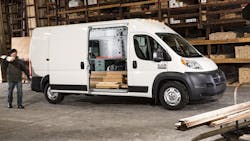Ram’s 2018 full-size, compact commercial vans enter the market
CHELSEA, MI. Ram Commercial Truck officially introduced its 2018 Class 2 full-size van segment and Class 1 compact van offering to the market today.
The ProMaster, Ram Commercial’s entry for the Class 2 full-size van segment, offers a front-wheel-drive system, reducing weight and complexity by locating all components beneath the cab. According to Ram, this keeps the cargo load floor height and step-in height very low and helps in low-traction surfaces, like snow, since there is always weight on the front wheels to provide traction.
The Ram Commercial brand started in 2012. And in 2014, Ram started incorporating front-wheel drive on all its van models, which David Sowers, head of Ram Commercial Truck, explained is a unique offering in that segment.
According to Sowers, front-wheel drive gives ProMaster vans better turning radius, lower load floor height in the back for better payload capability, and better traction. He also noted that front-wheel drive is beneficial for any industry that hires untrained drivers.
New features for 2018 include:
- Uconnect 5.0 now standard equipment with optional navigation
- Integrated Voice Command with Bluetooth is now standard along with steering wheel mounted audio controls
- Rear backup camera now standard on all models and backup camera kit with Chassis Cab and Cutaway models
- Right and left sliding doors now feature a window grate with fixed glass option
- The 2018 Ram ProMaster features the 3.6-liter Pentastar V-6 engine and a torque-laden, 3.0-liter EcoDiesel I-4 engine. The engines are paired, respectively, with a six-speed automatic transmission and an electronically controlled Dual Active Drive six-speed automated manual
The ProMaster City is Ram Commercial’s Class 1 compact van offering designed and engineered with a cargo volume of 131.7 cubic feet and payload capacity of 1,883 lbs.
Similar to the full-size van offering, the ProMaster City features Uconnect 5.0 and a standard backup camera. The van also features sliding and back door window grates available in vans without partitions.
Both models include an augmented reality mobile app to give customers a better idea of different height and storage configurations for each van.
Highlights for the 2018 ProMaster City include:
- Available in two-seat Tradesman cargo van and five-seat passenger wagon configurations in two different trims (Tradesman and SLT)
- Fuel economy of 29 miles per gallon
- 178 horsepower and 174 lb.-ft. of torque mated to an exclusive nine-speed automatic transmission
- Cargo width and length – 60.4 inches and 87.2 inches
- Distance between wheel wells – 48.4 inches
- Wheelbase – 122.4 inches
- Cargo area width of 60.4 inches, a cargo area height of 51.8 inches and a step-in height of 21.5 inches
During an interview with Fleet Owner at FCA’s What’s New event at the Chelsea Proving Grounds back in June, Sowers noted that for the past two years, sales of larger heavy-duty vans experienced double-digit growth even though sales in the small van segment in North America plateaued. He attributed larger van growth to low fuel prices and fleets’ need for better payload capability.
Sowers explained that over three to five years of use and operation, vans get heavier and heavier a little bit at a time with more vocational use. So where a fleet manager may have spec’d the vehicle properly to start with, over time, it starts to stretch the limits of the payload.
“With cheap fuel prices it’s easier to go back to a large van and solve that problem,” Sowers stressed. “What we’re seeing now is that there are some customers that switching back into large van and certainly from a growth perspective the large van segment is growing more than the small van segment.”
Because of this trend, Ram has seen a significant uptick of its ProMaster vans. Sowers noted that its van segment experienced growth of over 30% year to date in its sales from last year.
Another trend Sowers has seen at Ram is that fleets are making more rational decisions when it comes to purchasing commercial vans because there are more choices in the market. Fleet managers are now focusing more on a van’s capability, efficiency or cost of ownership, and reliability.
About the Author

Cristina Commendatore
Cristina Commendatore is a past FleetOwner editor-in-chief. She wrote for the publication from 2015 to 2023.

